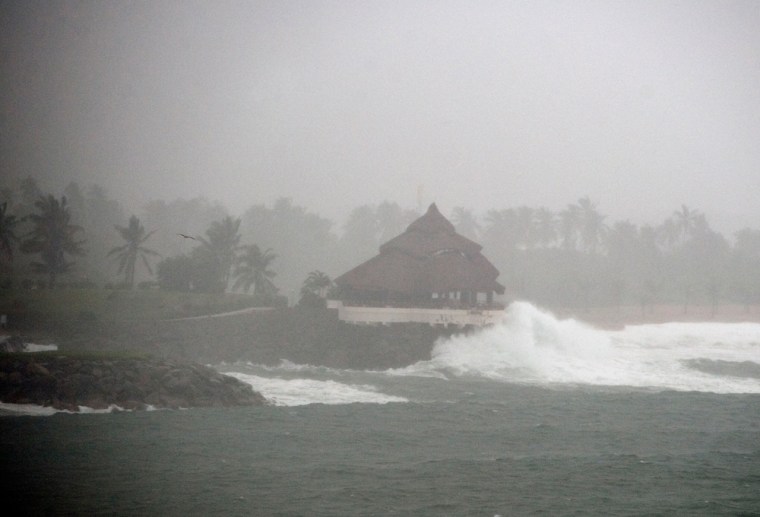Hurricane Jova bore down on a vulnerable Mexican coastline late Tuesday as people hunkered down in homes and shelters in tourist resorts and flood-prone mountain villages.
Jova had weakened some before swirling to within 60 miles of shore, but it still had maximum sustained winds of 100 mph, the U.S. National Hurricane Center reported. The forecast path pointed to landfall in the middle of the night between Barra de Navidad and the larger resort of Puerto Vallarta to the north.
As the storm's leading rain bands began swatting at the coast Tuesday night, heavy rain fell in the port city of Manzanillo and strong winds made palm trees sway.
Earlier Tuesday, marines visited flood-prone areas in Manzanillo to advise people to leave. They found a home for elderly people already flooded and evacuated 37 residents to relatives' homes, Adm. Jaime Mejia said.
Forty others were evacuated in the nearby town of Tecoman, Mejia said.
Jova was centered about 60 miles southwest of Manzanillo late Tuesday and was moving north-northeast at 8 mph, the U.S. hurricane center in Miami said.

Some people decided to ride out the storm, while others took refuge at shelters in towns like Jaluco, just inland from the beach community of Barra de Navidad.
"My house has a thatch roof, and it's not safe," said Maria de Jesus Palomera Delgado, 44, a farmworker's wife who went to an improvised shelter at a grade school in Jaluco, along with her 17 children and grandchildren.
"The neighbors told us the house was going to collapse" if hit by the hurricane, she added as the children slept nearby on folding cots packed into a classroom.
In an another classroom, migrant farmworker Rufina Francisco Ventura, 27, fed her 2-month-old son. She said she had left the ranch where she plants chilies and tomatoes planning only to pick up some free blankets, but shelter workers "told me I shouldn't leave here, because it's going to hit hard."
Jalisco state authorities evacuated about 200 people to shelters by Tuesday and was issuing alerts over loudspeakers placed in communities long the coast, telling people to take precautions as the hurricane approached, state civil defense spokesman Juan Pablo Vigueras said. The state had 69 shelters ready, he said.
Authorities also set up shelters for residents of inland towns, where the mountainous terrain could cause flash floods and mudslides, which often pose the greatest dangers in hurricanes.
"We have about 100 officials working in these communities, telling people they should evacuate," said Francisco Garnica, the duty officer at the Jalisco state civil defense office. But many were reluctant to leave their homes for fear they would be robbed. "They are worried about their possessions," he said.
The Mexican army said it had assigned about 1,500 soldiers to hurricane preparedness and relief efforts.
Jova was expected to hit the states of Jalisco, Colima and Nayarit the hardest. About 183,000 people live in the center of the storm's projected path, said Laura Gurza, chief of the federal Civil Protection emergency response agency.
The U.S. hurricane center in Miami warned that storm surge was expected to produce significant coastal flooding between the major seaport of Manzanillo, east of Barra de Navidad, and Cabo Corrientes, southwest of Puerto Vallarta.
Jova could unleash as much as 20 inches in isolated areas as it moved inland.
Hotels in Barra de Navidad and the neighboring beach town of Melaque dragged in beach furniture and advised their guests to leave the towns.
But some tourists seemed unfazed.
Bill Clark, a 59-year-old traveler from Santa Rosa, California, ate tacos at a street stand while enjoying a balmy Monday night.
"Some people are going out of town but I'm not really worried," said Clark, who has been coming to the town of about 3,000 people since 1994. "I'm from California, I have been through earthquakes."
Christoph Dietschi, 42, and his wife, four children and mother-in-law had checked in to a small beachside hotel in Melaque for a family wedding, but left Monday after the manager told them he couldn't guarantee their safety or service when the hurricane hit. They rented an apartment in Manzanillo.
"It was better to leave because they can't guarantee that everything would be OK for us. Maybe there is no electricity, no water, so it's better to leave," Dietschi said.
Dietschi walked Manzanillo's cobblestone streets with his family under just one umbrella to the beach of La Audiencia on Tuesday afternoon to watch the gray sky and choppy sea before the hurricane.
"We still hope that Saturday everything is all right," said Diestschi. His brother-in-law is scheduled to get married at a church in Barra de Navidad on Saturday.
Heavy rains in Manzanillo forced restaurants and stores to close Tuesday afternoon. Employees at convenience stores boarded up or taped their windows. Soldiers patrolled the main seaside avenue.
Authorities shut down Manzanillo's port, the biggest cargo center on Mexico's Pacific coast, and the nearby port of Nuevo Vallarta.
A hurricane warning was in effect for a 100-mile stretch of coast from just south of Puerto Vallarta to a point south of Manzanillo. A tropical storm warning was in effect farther south, to the port of Lazaro Cardenas.
In 1959, an unnamed hurricane struck near Manzanillo, reportedly killing 1,000 people. Detailed reports on hurricanes were not available at the time.
The hurricane was expected to be dissipating by the time the Pan American Games start Friday in nearby Guadalajara.
Meanwhile, Tropical Storm Irwin regained some strength farther out in the Pacific with winds near 45 mph. While it was expected to move eastward toward land, forecasts indicated it probably wouldn't make landfall.
